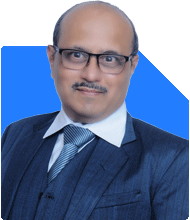Ramalingam Kalirajan |10893 Answers |Ask -Follow
Mutual Funds, Financial Planning Expert - Answered on Jun 18, 2024
He has an MBA in finance from the University of Madras and is a certified financial planner.
He is the director and chief financial planner at Holistic Investment, a Chennai-based firm that offers financial planning and wealth management advice.... more

I am 43 years old and wife 40 years , both are earning 450000 per month. We have a home loan of 70Lakh. Monthly we are investing PPF-25000 MF-70000 started 2 months back-April24 LIC- 55000 per year FD-20Lakh Planning to retire at the age of 55 with a retirement fund of 15CR. Any further suggestions?
You and your wife have a combined monthly income of Rs 4,50,000. This is a substantial income that can significantly contribute to your financial goals. Your current investments include Public Provident Fund (PPF), mutual funds, Life Insurance Corporation (LIC) policies, and fixed deposits (FDs). Additionally, you have a home loan of Rs 70 lakh. Your goal is to retire at the age of 55 with a retirement fund of Rs 15 crore.
Your current investment breakdown is as follows:
PPF: Rs 25,000 per month
Mutual Funds: Rs 70,000 per month (started two months ago)
LIC Policies: Rs 55,000 per year
Fixed Deposits: Rs 20 lakh
With 12 years left until your desired retirement age, it is essential to assess your financial strategy to ensure you meet your retirement goal.
Assessing Your Investments
Public Provident Fund (PPF)
PPF is a safe and tax-efficient investment option with guaranteed returns. The interest earned is tax-free, and the principal is secure. However, PPF has a lock-in period of 15 years, which may limit liquidity. Given your investment of Rs 25,000 per month, this is a good foundation for a stable, low-risk investment.
Mutual Funds
Your mutual fund investment of Rs 70,000 per month is a smart choice. Mutual funds offer potential for high returns, especially when invested for the long term. Since you've just started two months ago, it is crucial to stay consistent and review the performance periodically. Actively managed funds, compared to index funds, offer the advantage of professional management and the potential to outperform the market.
LIC Policies
LIC policies typically combine insurance and investment. These policies often provide lower returns compared to pure investment products like mutual funds. Considering your substantial premium of Rs 55,000 per year, it may be worth reassessing if these policies align with your retirement goals. You might consider surrendering these policies and reallocating the funds to more efficient investment vehicles.
Fixed Deposits (FDs)
FDs are a safe investment with guaranteed returns. However, the returns on FDs are often lower than other investment options, especially after adjusting for inflation. Your current investment in FDs is Rs 20 lakh. While it is good for liquidity, relying too heavily on FDs may not help you achieve your Rs 15 crore retirement goal efficiently.
Home Loan Considerations
A home loan of Rs 70 lakh is a significant liability. Paying off the loan before retirement is advisable to reduce financial stress during your retirement years. Ensure that you have a plan to manage this liability effectively, possibly by increasing EMI payments or making lump-sum prepayments when possible.
Recommendations for Future Financial Strategy
Increase Mutual Fund Investments
To achieve your retirement goal of Rs 15 crore, consider increasing your monthly mutual fund investments. Actively managed funds can provide higher returns over the long term. It would be beneficial to consult with a certified financial planner (CFP) to choose the right funds that align with your risk tolerance and financial goals.
Review and Reallocate LIC Policies
Evaluate your LIC policies critically. If they are not performing well or if the returns are not meeting your expectations, consider surrendering them. The funds from these policies can be better utilized in mutual funds or other high-return investments.
Reduce Fixed Deposit Holdings
Fixed deposits provide security but offer lower returns. Consider reducing your holdings in FDs and reallocating some of these funds to mutual funds or other growth-oriented investments. This will help in generating higher returns in the long run.
Utilize Tax-efficient Investment Options
Tax planning is an essential aspect of investment. Maximize the use of tax-efficient instruments like PPF, Equity Linked Savings Schemes (ELSS), and National Pension System (NPS). These instruments not only provide tax benefits but also help in building a substantial corpus over time.
Emergency Fund
Ensure you have an adequate emergency fund. This fund should cover at least 6-12 months of your household expenses. An emergency fund is crucial to handle unexpected financial challenges without disrupting your investment strategy.
Importance of Regular Financial Review
Regularly reviewing your financial plan is vital. Market conditions, interest rates, and personal circumstances change over time. A certified financial planner can help you stay on track with periodic reviews and adjustments to your investment strategy.
Professional Guidance
While you may have a good understanding of financial products, professional guidance can provide a structured approach. A certified financial planner can offer personalized advice, helping you optimize your investments and ensure that your financial goals are met.
Planning for Retirement Lifestyle
Your retirement planning should also consider the lifestyle you wish to maintain. Factor in inflation and rising costs of living. Your retirement corpus of Rs 15 crore should be able to sustain your lifestyle for 25-30 years post-retirement.
Healthcare Costs
Healthcare is a significant expense during retirement. Ensure you have adequate health insurance coverage. This will protect your retirement corpus from being depleted by medical expenses.
Long-term Care
Consider the potential need for long-term care or support services in your retirement planning. Including these costs in your financial plan will provide a more realistic picture of your retirement needs.
Creating a Diversified Portfolio
Diversification reduces risk and improves the chances of achieving stable returns. A balanced portfolio with a mix of equity, debt, and other assets can provide stability and growth. Ensure that your investment strategy includes a diversified approach.
Equity Investments
Equity investments, particularly through mutual funds, can provide high returns. Over the long term, equities tend to outperform other asset classes. Maintain a significant portion of your portfolio in equities to achieve your retirement goal.
Debt Investments
Debt investments, such as PPF and bonds, provide stability and regular income. These investments are less volatile compared to equities and can be a good counterbalance in your portfolio.
Gold and Other Commodities
Gold can act as a hedge against inflation. Including a small portion of your portfolio in gold or gold-related investments can provide diversification and protection against economic uncertainties.
Evaluating Investment Performance
Consistently monitor and evaluate the performance of your investments. This will help in identifying underperforming assets and making necessary adjustments. Use performance benchmarks and compare the returns of your investments with industry standards.
Conclusion
Achieving a retirement corpus of Rs 15 crore is a challenging but achievable goal. By increasing your mutual fund investments, reassessing LIC policies, reducing reliance on fixed deposits, and regularly reviewing your financial plan, you can stay on track to meet your retirement objectives.
Your disciplined approach to saving and investing, coupled with professional guidance, will ensure a secure and comfortable retirement. Stay focused, stay informed, and make adjustments as necessary to adapt to changing circumstances.
Best Regards,
K. Ramalingam, MBA, CFP,
Chief Financial Planner,
www.holisticinvestment.in
You may like to see similar questions and answers below
Ramalingam Kalirajan |10893 Answers |Ask -Follow
Mutual Funds, Financial Planning Expert - Answered on Jun 11, 2024
Ramalingam Kalirajan |10893 Answers |Ask -Follow
Mutual Funds, Financial Planning Expert - Answered on Jul 18, 2024
Ramalingam Kalirajan |10893 Answers |Ask -Follow
Mutual Funds, Financial Planning Expert - Answered on Feb 08, 2025
Ramalingam Kalirajan |10893 Answers |Ask -Follow
Mutual Funds, Financial Planning Expert - Answered on Aug 04, 2025
Ramalingam Kalirajan |10893 Answers |Ask -Follow
Mutual Funds, Financial Planning Expert - Answered on Jul 18, 2025
Nitin Narkhede |113 Answers |Ask -Follow
MF, PF Expert - Answered on Dec 15, 2025
Nitin Narkhede |113 Answers |Ask -Follow
MF, PF Expert - Answered on Dec 15, 2025
Ramalingam Kalirajan |10893 Answers |Ask -Follow
Mutual Funds, Financial Planning Expert - Answered on Dec 15, 2025
Ramalingam Kalirajan |10893 Answers |Ask -Follow
Mutual Funds, Financial Planning Expert - Answered on Dec 15, 2025
Radheshyam Zanwar |6746 Answers |Ask -Follow
MHT-CET, IIT-JEE, NEET-UG Expert - Answered on Dec 15, 2025
Ramalingam Kalirajan |10893 Answers |Ask -Follow
Mutual Funds, Financial Planning Expert - Answered on Dec 15, 2025
Ramalingam Kalirajan |10893 Answers |Ask -Follow
Mutual Funds, Financial Planning Expert - Answered on Dec 15, 2025
Ramalingam Kalirajan |10893 Answers |Ask -Follow
Mutual Funds, Financial Planning Expert - Answered on Dec 15, 2025
Samraat Jadhav |2508 Answers |Ask -Follow
Stock Market Expert - Answered on Dec 15, 2025
Ramalingam Kalirajan |10893 Answers |Ask -Follow
Mutual Funds, Financial Planning Expert - Answered on Dec 15, 2025
























